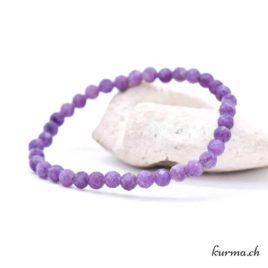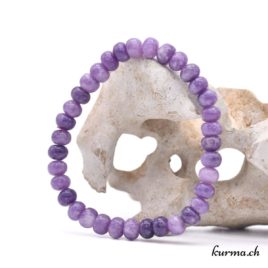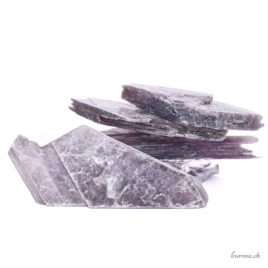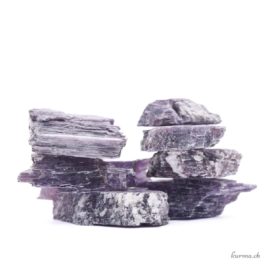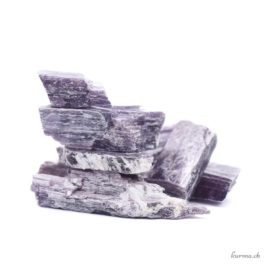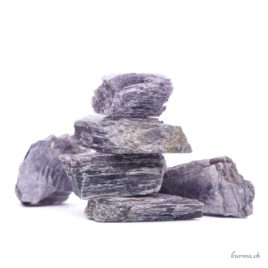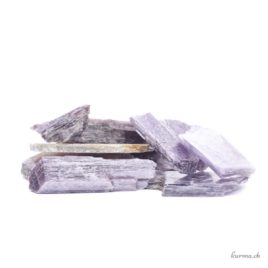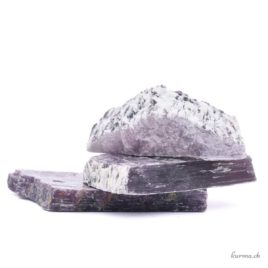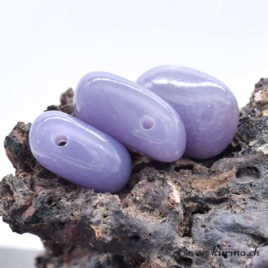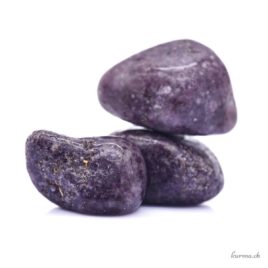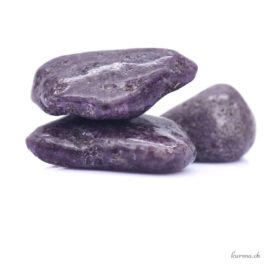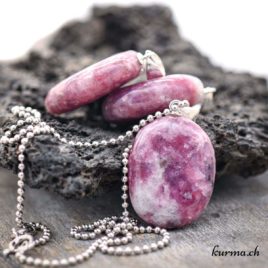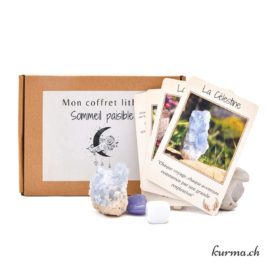Lepidolite
gemstones, minerals, bracelets, pendants, rolled stones
Sometimes referred to as the "transition stone" of lithotherapy, Lepidolite accompanies change.
This lithium-rich mica, protector and stabilizer, may ward off nightmares.

What are the properties and benefits of Lepidolite in lithotherapy?
The origins of the symbol
It used to be called Lilalite; but in 1975, a German mineralogist and chemist gave it the name Lépidolite (from the Greek lepidion (small scale) and lithos (stone). For Martin Heinrich Klaproth, the name Lilalite didn't meet scientific standards - let's bet that if he were to go through the names and nicknames given to stones today, he'd be turning over in his grave.
But this image should not mislead us as to the wisdom of its symbols. With its flaky, lithium-rich appearance, the stone is graceful, fragile and rather rare.
Contemporary esotericism links it to symbols of transformation, reconciling emotional liberation and peace of mind at the end of a journey.
Properties and virtues in lithotherapy
What does it mean?
Lepidolite symbolizes trust in one's own power of transformation.
What are its benefits?
In search of spiritual peace, she can accompany you on the path of self-knowledge, helping you to free yourself from repressed emotions, to prevent you from past wounds, or more simply to grow as a human being in search of autonomy.
The journey of change is also a quest for emotional balance, to overcome anxiety and perhaps depression. Lepidolite will also be a good support in cases of nervousness and sleep disorders: it will help you get through moments of fear that could stand in the way of achieving a goal or your well-being, and the stone's energy can be useful for improving sleep in cases of insomnia or nightmares.
Physical effects
There is no scientific proof of Lepidolite's physical effects, but there is a tradition and a reputation:
- It is said to calm the nervous system due to its high lithium content: considered a support stone for people suffering from disorders such as ADHD, post-traumatic stress disorder (PTSD), hyperactivity, bipolarity, schizophrenia, depression and OCD, it strengthens psychic balance by helping to dispel negativity and gain self-confidence through a serene attitude.
- Its lamellar structure provides effective protection against "negative" energies and electromagnetic waves.
- It is said to detoxify the body and relieve pain, particularly stomach ache and pain caused by inflammation.
- It may also help relieve skin rashes and allergies.
How to use Lepidolite
- For bedtime anxieties, night fears or nightmares, place a Lepidolite directly under your pillow (or under the sheet if you're in a child's bed, where it could be swallowed).
- To enjoy its benefits every day, carry a Lepidolite on your person, in your pocket or as a piece of jewelry.
- In case of pain or rashes, place a Lepidolite directly on the affected area.
Where to place a Lepidolite?
- Lepidolite in your home will have a protective effect.
- Place it directly on your Wi-Fi router as protection against electromagnetic waves.
- In your hallway or any other place where protection against unwanted energies makes sense. The most effective is to place it in the 4 corners of your house or apartment and, for a more complete protection, you can combine it with Black Tourmaline, Shungite, Rose Quartz, Rock Crystal or Black Spinel.
- In your office or workplace, to prevent outside influences from disrupting your decisions or holding you back from achieving your goals, or to calm your nervousness or hyperactivity.
- In your bedroom, for a peaceful, anxiety-free sleep.
Lepidolite, for whom?
- Lepidolite is an ally for children who are afraid of the dark, have nightmares or night terrors, or and with all kinds of fears.
- It is ideal for people who are frequently nervous, hyperactive or highly sensitive to the energies present in their environment.
- It's perfect for and who are easily influenced or who always need others to act.
What stones and crystals should Lepidolite be associated with?
- To promote peaceful sleep and sweet dreams, place a Lepidolite with a translucent Selenite or Gypsum under your sheet.
- for protection against all types of undesirable energies and electromagnetic waves, combines Lepidolite with black Tourmaline, known as Schorl, or Shungite, a carbonaceous rock.
- to soothe anxiety, burn-out, addictions, hyperactivity or any situation that is difficult to cope with in terms of emotions or responsibility, the combination of Lepidolite with a variety of Smoky Quartz can work wonders.
Refilling and cleaning
How to purify Lepidolite?
On a bed of salt, under the Full Moon / quick rinse with clear, distilled or spring water and dry with a cloth or in the open air / waveform (flowers of life or sacred geometries) / fumigation (white sage or palo santo between 30 and 60 seconds) / singing bowl, Tibetan bells or tuning fork, natural breath/wind / intentionCare to avoid
Do not immerse Lepidolite in water for long periods.
Do not expose it to direct sunlight for too long, as this may alter its color and structure.
Chakras
Heart chakra (Anahata)Third eye (Ajna) chakra
Coronal chakra (Sahasrara)
spiritual perspective of all three: opening up to higher vibrations, connecting to intuition, integrating emotional experiences
Astrological signs
Libra, Pisces, Aquariussupport their sensitivity, their quest for harmony and their spiritual openness
Element
Airthoughts, emotions, communication
Lepidolite mineralogy
Lepidolite is a lithium-bearing trioctahedral variety of mica.
It belongs to the class of lamellar silicates and consists essentially of aluminum, silica, fluorine, potassium, bohrium, oxygen and lithium.
Its color, which can be violet, mauve, purplish blue, pink or gray, comes from the lithium and traces of manganese, cesium and iron that may be present in the composition of Lepidolite.
It has a shimmering and pearly appearance, often in the form of plates, glittering or laminated aggregates or as a hemispherical mass, often in layers called "books".
Its formation takes place in very specific geochemical environments, notably in pegmatites (where lithium concentration is high enough to allow crystallization).
Some Lepidolites fluoresce under a UV lamp.
Its largest deposits are in Brazil, Afghanistan, the United States and the Czech Republic.
Its hardness lies between 2.5 and 4 on the Mohs scale: it is a relatively soft stone, which limits its use in jewelry. It is also used as an ornamental stone in gemology.
Curiosities
Lepidolite is used to extract lithium, a very light metal used on a large scale in the technology industry since the 1920s - in various fields such as batteries for electronic devices, the manufacture of special glass, medicine and others.
Lithium has been used for over a century to produce the red color of fireworks.
Apart from its relatively recent industrial use, Lepidolite has been little used as a gemstone for jewelry. Today, however, it is enjoying great success for its therapeutic properties.
Lithotherapy
- Element(s) :
- Zodiac(s) :
- Cancer, Leo, Aquarius
- Purification :
- Singing bowl, Water, Fumigation, Moon, Form waves, Breath
- Physics :
- Detox, Stomach, Nervous system, Skin
- Emotional :
- Anxiety, Self-confidence, Self-esteem, Self-image, Nervousness, Fear, Balance
- Spiritual :
- Harmony, Intuition, Protection
- Disorder(s):
- Depression, Hyperactivity
- Miscellaneous :
- Protection
Mineralogy
- Hardness :
- 2.5-4.0
- Moths scale:
- 2, 3, 4
- Strunz classification :
- Silicate
- Crystalline system :
- Monoclinic
- Chemical element :
- K, Li, Al, Si, O, F, H
- Line color :
- White, pale pink
- Density :
- 2.8-2.9
- Cleavage :
- Perfect
- Fracture:
- Uneven, flexible, elastic
- Transparency :
- Transparent to translucent
- Refringence :
- nα = 1.525-1.548, nβ = 1.551-1.585, nγ = 1.554-1.587
- Birefringence :
- Biaxial (-); 0.0290-0.0380, 2V = 25-58°.
- Pleochroism :
- X: mostly colorless; Y = Z: pink, pale violet
- Fluorescence :
- Creamy white to pale yellow under medium-intensity UV. Sometimes yellow.
- Colors :
- Colorless, white, grayish, grayish white, grayish green, yellowish, greenish, pale red, pink, violet, purple
- Magnetism :
- no
- Radioactivity :
- no
To calm nervousness
*Please note! Some minerals may be toxic and must not be licked or ingested (as such or in the form of powder, elixir or stone water) or be in prolonged contact with the skin or mucous membranes.
*The information on the stones described here are general indications based on our research and experience, and are not exhaustive.
Reproduction in whole or in part of this content is prohibited. More info

